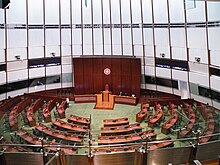


![]() listen)), officially the Hong Kong Special Administrative Region of the People's Republic of China, is a specially administered region on the eastern side of the Pearl River estuary in southern China. With over 7.4 million Hongkongers of various nationalities[c] in a territory of 1,104 square kilometres (426 sq mi), Hong Kong is the fourth-most densely populated region in the world.
listen)), officially the Hong Kong Special Administrative Region of the People's Republic of China, is a specially administered region on the eastern side of the Pearl River estuary in southern China. With over 7.4 million Hongkongers of various nationalities[c] in a territory of 1,104 square kilometres (426 sq mi), Hong Kong is the fourth-most densely populated region in the world.

